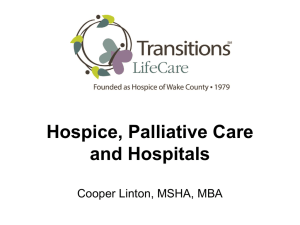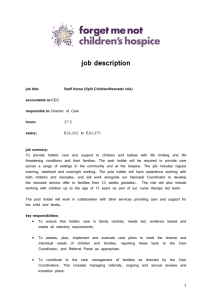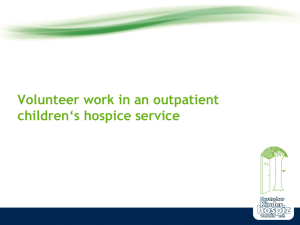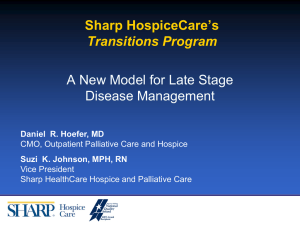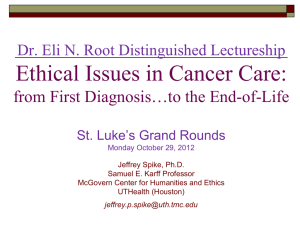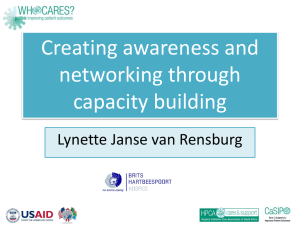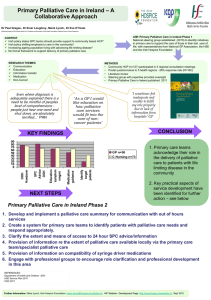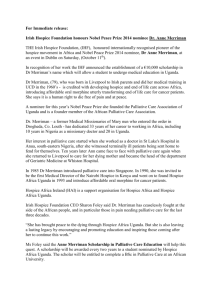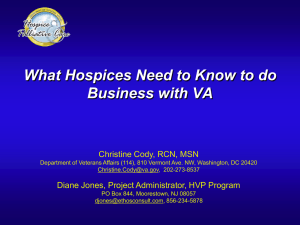Palliative Care for End Stage Heart Disease
advertisement
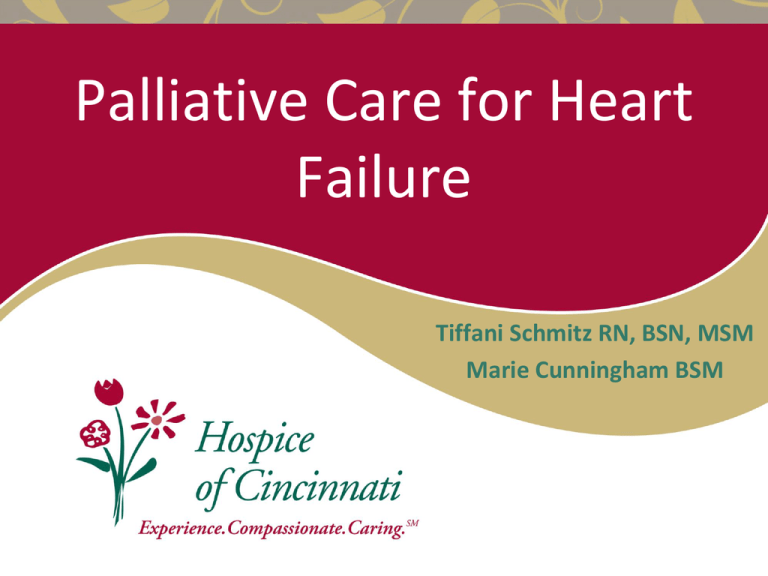
Palliative Care for Heart Failure Tiffani Schmitz RN, BSN, MSM Marie Cunningham BSM Objectives 1. Describe the admission history and pattern of patients with end stage heart disease in the last twelve months of life as identified by research results. 2. Identify an evidence based, quantifiable measure to determine the most appropriate time to refer to palliative care or hospice care. 3. Describe key palliative interventions for patients with end stage heart disease. 2 Industry Trends Number of deaths from chronic illness is approximately 70% 2,450,000 US Deaths 1,020,000 Hospice Deaths 41.6% 3 *NHPCO Data 2009 NHPCO estimates nearly 41.6% of all deaths in the US were under the care of a hospice program * US Causes of Death 2010 CDC 4 Percentage of Hospice Admissions by Primary Diagnosis 6% CA 4% Alz/Dementia 7% 35% 8% CHF COPD CVA 8% 14% Sepsis Failure to Thrive 5 2010 NHPCO Facts and Figures on Hospice Care Important Needs Going Unmet 6 Late Referrals Undermine Hospice Value 7 The 2010 HF Society of America Comprehensive HF Practice Guidelines End of Life care should be considered in patients who have advanced, persistent HF with symptoms at rest despite repeated attempts to optimize pharmacologic, cardiac device and other therapies, as evidenced by 1 or more of the following: Heart Failure Hospitalization 8 Chronic poor quality of life with minimal or no ability to accomplish ADL’s Need for continuous intravenous inotropic therapy Challenges in Determining “End of Life” Most are fairly stable Difficult to put a 6 Month time frame on patients with chronic diseases 9 Develop new levels of normal Accustomed to symptom exacerbation Challenges in determining “End of Life” Would I be surprised if my patient died within the next twelve months? A study that looked at physician prognostic accuracy in terminally ill patients found 63% of physicians were overly optimistic in estimating survival 10 The closer the relationship to the patient, the longer the prognosis Overall, physicians overestimated survival by a factor of 5.3 Or 530% BMJ 2000; 320: 469-473 Median 2-month Survival Estimate Prognosis Stays Uncertain Through Most of the Last Part of Life 0.8 Congestive heart failure 0.6 0.4 Lung cancer 0.2 0.0 7 11 6 5 4 Days before Death 3 2 * From SUPPORT, 1988-93 1 The Research Can the admission history alone indicate when to refer to hospice or palliative care? Retrospective review of charts 12 Adult patients who died at TriHealth hospitals from a chronic illness between April 2005 and October 2004 Review of 441 cases Key Outcome Yes! The Admission history alone is a reliable tool to use to determine when to refer to hospice or palliative care. Keep in Mind: Recurring hospitalizations are often inconsistent with the patient’s priorities, quality of life, and wishes 13 Hospice care reduces readmissions to the hospital Recurring Hospitalizations are costly to the hospital Financial Implications 441 patients in the study incurred a $1,700,000 loss for TriHealth Total cost less total payment Takes into consideration the direct and indirect cost of providing care 14 Average Number of Admissions 15 Mean Admissions for Heart Patients 22 16 Cost of Readmission within 30 Days $17.4 billion spent in 2004 in the US for unplanned Medicare re-hospitalizations Approximately 28% of re-hospitalizations are avoidable $12 billion of this was for potentially preventable re-hospitalizations 17 Healthcare Reform Act Patient Protection and Affordable Care Act includes Value Based Purchasing (VBP) implemented March 2010 VBP is a Medicare system that considers quality of care in determining payment to individual providers Hospitals will be penalized financially if their readmissions for heart failure, AMI, and pneumonia exceed national benchmarks 18 Palliative Care Hospice Care 19 Comfort Care Curative Care Hospice vs. Palliative Care Why Focus on End Stage Heart Disease? A 2008 Medpac report made recommendations to change the payment rate to hospitals with high re-admissions Patients admitted with heart failure have shorter hospital LOS, but higher rates of re-admissions within 30 days (Jama, June 2, 2010) 20 Trend of the HF patient Orientation •Status quo •Symptom exacerbation •In and out of acute care •With every admission may hit ‘new normal’ but maintaining at a new low •Disease is the focus 21 Disorientation •Bad news-chaos •No language •Unfamiliar territory •Too difficult, too hard, too scary, too visceral New Orientation •New normal •Most are not ready for “newness” •Creating moments of joy; healing happens and may be seen as a gift and a surprise • Promote openness and understanding •Disease is in the background Comparing Hospice and Nonhospice Patient Survival 81 Days Hospice care resulted in an average increase of life by 29 days. 39 Days 21 Days Retrospective statistical analysis of 4493 patients from 5% of Medicare patients from 1998-2002 22 Connor SR et al. JPSM 2007; 33:238-46 What does 81 days mean to your patients? 23 End of Life Conversations Alone Have Positive Impact Advance cancer patients who had EOL discussions showed 35.7% in lower costs than those with no EOL discussions • Those who discussed EOL showed: 1 Higher tendency to want to know life expectancy 2 Acknowledgement of terminal illness 3 Less likely to favor futile care over comfort 4 Preference to avoid dying in the ICU 5 Higher likelihood to receive outpatient hospice care and earlier referral 24 Source: Health Care Costs in the Last Week of Life: Associations with EOL Conversations, Arch Inter Med 2009 Rate of Readmission for Heart Failure Patients Within 30 Days Number of Patients 25 319 584 103 403 Medicare data on patient discharged between July 1, 2006 and June 30, 2009. Hospitalcompare.hhs.gov HOC data from Jan 2011 though October 2011 Pathways for End Stage Heart Disease Effectively manage symptoms and avoid hospital re-admissions Nursing visits Cardiac medications Focus on patient and caregivers 24/7 Support Team Meet all levels of care Implement a plan of care to create a positive and meaningful end of life experience 26 Nursing Visits Tailored to meet needs of patient Aggressive symptom management Educate about disease process Create an effective plan of care 27 Medications Continue to utilize cardiac medications that are beneficial for symptom management • Cardiac comfort pack (Lasix, nitroglycerin, ASA, morphine) 28 Caregiver Focus Caregiver education, support and guidance 29 Prepare for the crisis to prevent readmissions Define patient and caregiver goals of care 24/7 Availability Break cycle of calling 911 or returning to hospital 30 Assure patient and family that someone will be there in a crisis Be proactive End of Life Program Yields Dramatic Improvement in Hospice Referrals and Hospital Admissions Goal: To identify patients early in the process so that referral to appropriate care and related community resources occurs in a timely fashion. 31 Source: Advisory Board, Franciscan Health System, Tacoma, Wash Meet all levels of care What happens if symptoms exacerbate? Create a plan to address acute care needs without hospitalizations Inpatient care center 32 Continuous care Address caregiver breakdown Palliative Care Saves Money and Improves End of Life Experience Patients assigned to in-home Palliative Care were more satisfied with care 20% were 13% were less more likely to likely to go to 33% lower 93% were die at home the ED or be costs than than the admitted to very satisfied patients with patients the hospital after 90 days standard care receiving than usual usual care care patients 33 1 Increasing Satisfaction with Care and Lower Costs: Results of a Randomized Trial of In-Home Palliative Care JAGS, The American Geriatrics Society, 2007 Help patients understand their options Physicians have a lot of power in influencing the elderly population 34 Most patients don’t have all the facts about hospice and palliative care They count on their doctors to tell them It is important that physicians take ownership in discussing end of life options Create a plan for your patients Have EOL conversations with your patients or partner with someone who can help you have these conversations Advance care planning (Living Will, HCPOA, DNR) Learn to Identify patients who meet EOL criteria Utilize programs that can work with you to meet the needs of your patients 35 Thank You (513) 891-7700
